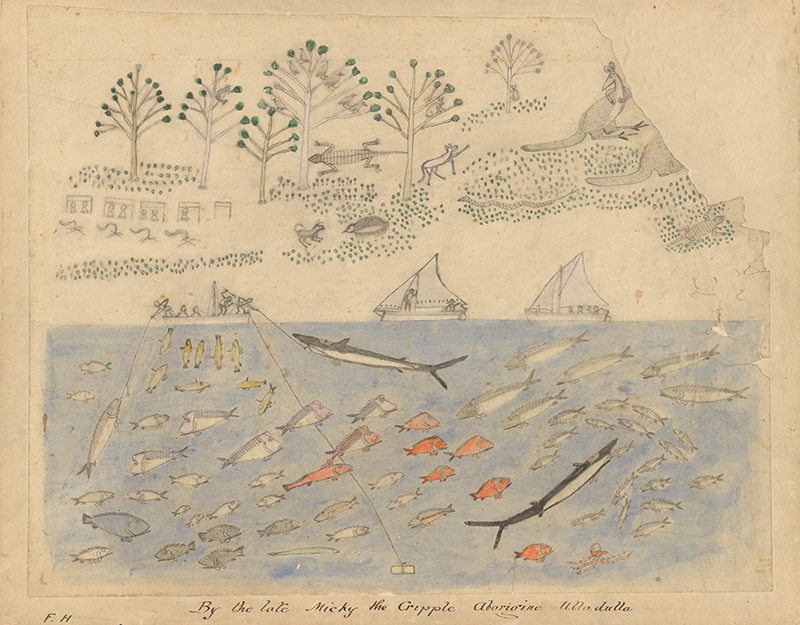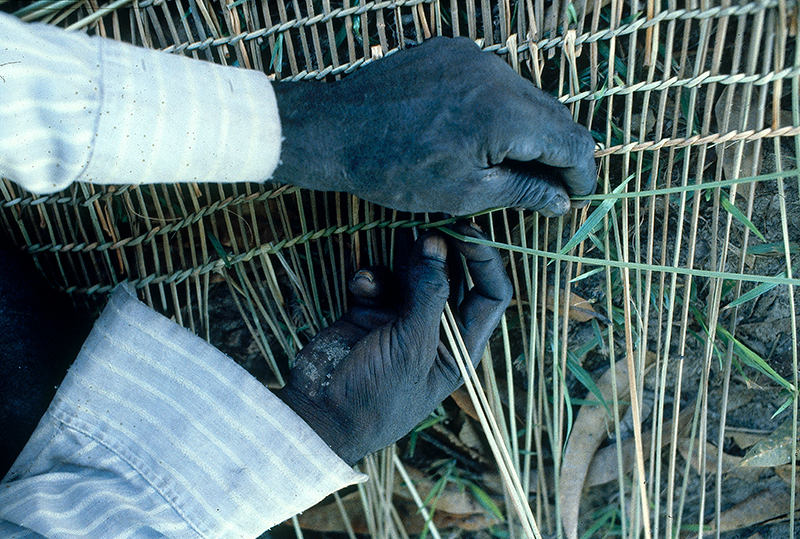‘We’ve been doing it [fishing] in this country thousands of years more than white men put together have been doing it; we know how fish react, we know how they travel, we know where they travel, we know what time of year they travel. Our parents taught us, we were brought up living off the sea.’ — Tom Butler, Murramarang Elder and retired commercial fisherman, 2016
For many Aboriginal and Torres Strait Islander peoples, fishing is as natural and as necessary as breathing. It forms part of the deep cultural and spiritual connection many communities have with their waters and marine resources. Whether saltwater or freshwater, fishing is a matter of cultural practice and is informed by traditional knowledge.

Fishing activities of Aboriginal people and settlers near Ulladulla, New South Wales, approximately 1885, Mickey of Ulladulla. Courtesy of the National Library of Australia, nla.obj-135516869.
Fishing activities of Aboriginal people and settlers near Ulladulla, New South Wales, approximately 1885, Mickey of Ulladulla. Courtesy of the National Library of Australia, nla.obj-135516869.

The men on Mornington Island traded the fish for tobacco. The fish were also used for dormitory children's meals, Mornington Island, Qld.1946. AIATSIS Collection BELCHER.D01.DF-D00018770.
The men on Mornington Island traded the fish for tobacco. The fish were also used for dormitory children's meals, Mornington Island, Qld.1946. AIATSIS Collection BELCHER.D01.DF-D00018770.
Connected to country and community
Many Aboriginal and Torres Strait Islander peoples have a strong relationship with the oceans or inland waterways that form part of their country. For saltwater communities, the sea is integral to many people’s concepts of country and identity.
‘This is who our family is. We are bound to the sea and we have fished together traditionally forever.’ — John Brierley, Yuin Walbunga self-employed fisherman, 2011
In northeast Arnhem Land, the Yolŋu peoples consider the land and the sea to be inseparably linked, both physically and culturally. Under Yolŋu law, traditional owners have an equal responsibility to look after the resources and environment of both their land and sea estates.
For thousands of years, Aboriginal and Torres Strait Islander people have used fishing to build a livelihood for themselves, their families and their communities. A catch of fresh fish provides a community with immediate subsistence and future trade and sale options, as well as employment. In this way, fishing is crucial for the continued success of coastal Aboriginal and Torres Strait Islander community economies.
In the Torres Strait, marine management arrangements provide Torres Strait Islanders with priority access to subsistence marine resources. Since 1985, new commercial licenses for fisheries such as trochus, pearl shell and crayfish have only been issued to traditional inhabitants.
Fishing technologies
Much coastal Indigenous fishing is done on the beach or in shallow pools. Shellfish such as cockles and crabs can be dug up from under the sand. Rock pools work as natural tidal fish traps to ensure that when the tide goes out fish are caught in the pools, ready to be speared.
On a larger scale, constructed stone weirs designed to trap fish in shallow lagoons with the falling tide can be found in most coastal areas of Australia. The construction of these traps over hundreds of years demonstrates the historical technological capability of Aboriginal people in these areas.
In areas along river and creek systems, such as Maningrida in the Northern Territory, people developed basket fish traps and hand-held nets made of woven fibres. Basket traps could be placed into creeks for use during king tides, while hand-held nets could be used at any time.
On Murruŋga Island in the Crocodile Islands, fish traps made of twined pandanus palm leaf are still in use today. For the most part, though, modern nylon nets have become most Aboriginal and Torres Strait Islander people’s marine technology of choice. The same weaving techniques can be used for both natural fibres and synthetic polymers to make and mend nets.

Fish trap – the trap will be positioned in the gate when the tide turns and water begins to flow out, Bulgai Plains, between Liverpool River and Tomkinson River, Arnhem Land, NT, 1978. Courtesy of Peter Cooke. AIATSIS Collection COOKE.P01.CS-000074171.
Fish trap – the trap will be positioned in the gate when the tide turns and water begins to flow out, Bulgai Plains, between Liverpool River and Tomkinson River, Arnhem Land, NT, 1978. Courtesy of Peter Cooke. AIATSIS Collection COOKE.P01.CS-000074171.

Frank Malgurda weaving a sedge grass 'drag net', Maningrida, Arnhem Land, NT, 1980. Courtesy of Peter Cooke. AIATSIS Collection COOKE.P01.CS-000074162
Frank Malgurda weaving a sedge grass 'drag net', Maningrida, Arnhem Land, NT, 1980. Courtesy of Peter Cooke. AIATSIS Collection COOKE.P01.CS-000074162
Another significant marine technology development is the use of rafts, canoes and boats along river systems and on open waters. Historically, dugout and bark canoes were used as transportation devices and as flotation aids while spear-fishing. Today, Aboriginal and Torres Strait Islander people primarily take dinghies out to fish, and use nets, spears and fishing lines with metal hooks rather than kangaroo bones.
Knowing where and when to fish
‘I think Aboriginal people have the common knowledge to know where they can fish and can't fish, it's in their blood, it's in their culture, it's been passed down from generations.’ — Sue Stewart, Yuin woman, 2016
Over the generations, Aboriginal and Torres Strait Islander peoples living near the sea have amassed a great deal of traditional knowledge around the best times and places to fish:
‘Tides will tell us [when to go out fishing]… the weather will tell us. Those balanda [white people], they’ve got fish radar but we don’t use that one. We know the places to get what we want, it’s there. What we don’t want, we just leave it.’ —Jonathan Yalandhu, Yolŋu man of the Gupapuyŋu clan, 2017
Yolŋu people describe this as seasonal knowledge. They know which season it is from the natural signs around them; different flowers in bloom, changes to the colour of leaves, changes in tides and winds. The signs and seasons tell them which fish and maypal (shellfish) are big and fat, ready to be taken. Changes in the colour and smell of the sea brought by algal blooms tell them when there are yindi maypal (big shellfish).
Wayne Haseldine, a Kookatha/Mirning man, describes knowing which fish species to target on particular days as a ‘natural instinct’ made up of his ability to read the tide, winds and the moon. This is the knowledge he wishes to teach to the next generation of his family.
With the advent of new technologies, Aboriginal and Torres Strait Islander peoples’ means of engaging in fishing and marine resource management has changed a great deal. But the traditional knowledge of how, where and when to gather marine food resources such as fish and shellfish hasn’t changed.
Take only what you need
In coastal Aboriginal and Torres Strait Islander communities, cultural rules about fishing are handed down orally through the generations.
‘Fishing is actually sacred to us; it’s really part of our culture. So if people want to go fishing and if they want to do it our way, then they’ll learn the sacredness. You never take more than you need, for a start.’ — Sue Haseldine, Kookatha/Mirning woman, 2017
This rule is widespread, and often accompanies two others: don’t take undersized or pregnant fish and don’t overfish. When fish are allowed to breed and grow, their populations are both sustainable and can sustain a community when taken at the right time.
In Aboriginal communities where cultural fishing practices have been handed down for thousands of years, people express frustration at not seeing commercial and recreational catch and release fishing boats following the same rules, showing respect to the marine environment and improving their efforts at fishing sustainability. When people in these communities see examples of bycatch and discarded dead fish, they see this as disrespectful of their culture and their country.
Many Yolŋu peoples in the Crocodile Islands believe that there are fewer fish in their waters due to commercial fishing. In Ceduna on the Far West Coast of South Australia, people worry about the impact on the local fish populations of the thousands of recreational fishers who visit every year.
In Ceduna, the Aboriginal community would like to see the advent of a sea ranger program, where local Aboriginal people could enforce fisheries regulations in a culturally appropriate way. Sue Haseldine wants to start a cultural eco-tourism business which would teach people respect for the land and the sea. These programs would not only provide employment, they would provide new opportunities for Aboriginal people to explain to outsiders the sacredness of their connection to sea country and the importance of respecting the cultural rules of fishing.
